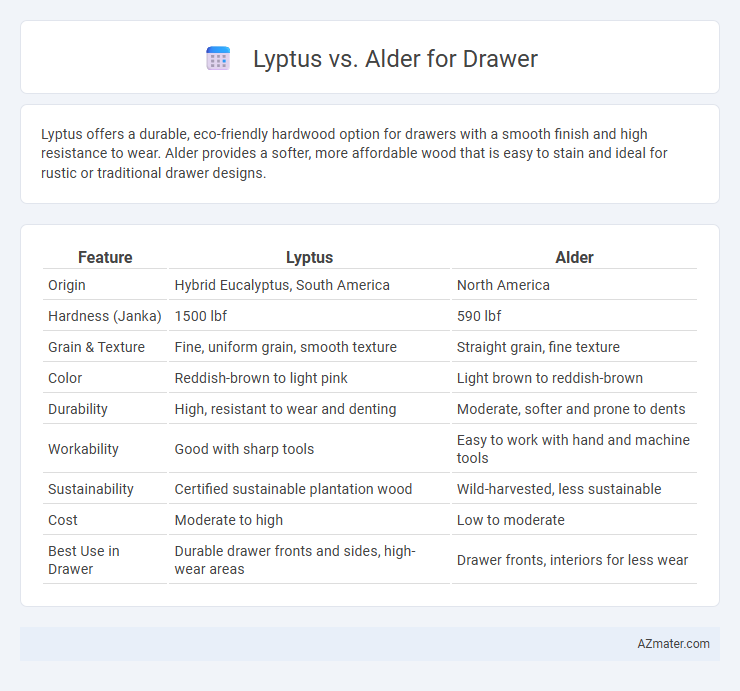Lyptus offers a durable, eco-friendly hardwood option for drawers with a smooth finish and high resistance to wear. Alder provides a softer, more affordable wood that is easy to stain and ideal for rustic or traditional drawer designs.
Table of Comparison
| Feature | Lyptus | Alder |
|---|---|---|
| Origin | Hybrid Eucalyptus, South America | North America |
| Hardness (Janka) | 1500 lbf | 590 lbf |
| Grain & Texture | Fine, uniform grain, smooth texture | Straight grain, fine texture |
| Color | Reddish-brown to light pink | Light brown to reddish-brown |
| Durability | High, resistant to wear and denting | Moderate, softer and prone to dents |
| Workability | Good with sharp tools | Easy to work with hand and machine tools |
| Sustainability | Certified sustainable plantation wood | Wild-harvested, less sustainable |
| Cost | Moderate to high | Low to moderate |
| Best Use in Drawer | Durable drawer fronts and sides, high-wear areas | Drawer fronts, interiors for less wear |
Introduction to Lyptus and Alder Wood
Lyptus is a sustainable hardwood hybrid derived from Eucalyptus species, known for its density, durability, and smooth finish, making it an excellent choice for drawer construction. Alder wood, a softer hardwood native to North America, offers a consistent grain pattern and warm reddish-brown hue, favored for its ease of machining and finishing. Both woods present distinct characteristics: Lyptus provides superior strength and resistance, while Alder excels in affordability and workability for cabinetry and drawer applications.
Key Characteristics of Lyptus
Lyptus wood is highly valued for drawer construction due to its exceptional hardness, durability, and fine, uniform grain, which provides a smooth finish that resists wear and tear. Compared to alder, Lyptus offers greater resistance to dents and scratches, making it ideal for high-traffic or frequently used drawers. Its sustainably harvested nature and dimensional stability further enhance its appeal in cabinetry and furniture making.
Key Characteristics of Alder
Alder wood offers a fine, consistent grain with a smooth texture, making it an excellent choice for drawers that require a refined, elegant finish. Its moderate hardness and good workability allow for easy shaping and sanding, while maintaining durability under everyday use. Alder also exhibits natural resistance to warping and shrinkage, ensuring long-lasting drawer construction and reliable performance.
Durability Comparison: Lyptus vs Alder
Lyptus wood, a hybrid Eucalyptus species, offers superior durability and resistance to wear compared to Alder, making it an excellent choice for drawer construction. Alder wood is softer and more prone to dents and scratches, which may reduce the longevity of drawers under heavy use. Lyptus' dense grain structure enhances its strength, ensuring drawers maintain structural integrity over time.
Workability and Machining Differences
Lyptus offers superior machinability due to its uniform grain and consistent density, allowing for clean cuts and smooth finishes in drawer construction. Alder, with its softer texture and more varied grain, can be prone to tear-out but is easier to shape and sand compared to Lyptus. The workability of Lyptus makes it ideal for precision joinery, while Alder excels in hand-tool responsiveness despite requiring more care during machining.
Appearance and Grain Patterns
Lyptus wood features a fine, uniform grain with a smooth texture and a warm, reddish-brown hue that deepens over time, creating an elegant and consistent appearance for drawers. Alder wood exhibits a more varied, straight to slightly wavy grain pattern with a lighter, creamy to reddish-brown color that adds a natural, rustic charm to furniture. Both woods enhance drawer aesthetics, but Lyptus offers a more refined, polished look while Alder provides a softer, more organic visual appeal.
Environmental Impact and Sustainability
Lyptus, a hybrid eucalyptus hardwood, grows rapidly and is harvested from sustainably managed plantations, reducing deforestation and promoting carbon sequestration. Alder, typically sourced from natural forests, has a slower growth rate and may contribute to habitat disruption if not responsibly managed. Choosing Lyptus for drawer construction supports sustainable forestry practices and lowers the environmental footprint compared to traditional Alder wood.
Cost Analysis: Lyptus vs Alder Drawers
Lyptus wood generally costs more than alder due to its sustainable harvesting practices and higher density, which offers better durability for drawer construction. Alder is more affordable and widely available, making it a budget-friendly choice for drawer manufacturing with moderate strength and a consistent grain pattern. Choosing between Lyptus and Alder drawers depends on balancing upfront material costs against long-term durability and aesthetic preferences.
Best Uses for Lyptus and Alder in Drawer Construction
Lyptus is best used in drawer construction where durability and resistance to wear are critical, as its dense grain and hardness provide excellent strength and smooth finishes ideal for heavy-use drawers. Alder offers a softer, more workable option, favored for decorative drawer fronts or lighter storage solutions thanks to its fine, uniform texture and ease of shaping. Choosing Lyptus supports longevity and structural integrity, while Alder allows for versatile design and detailed craftsmanship in cabinetry.
Final Verdict: Choosing the Right Wood for Drawers
Lyptus offers a durable, dense hardwood ideal for drawers requiring resistance to wear and moisture, while Alder provides a softer, more affordable option with a smooth grain that is easy to finish and shape. The final verdict depends on drawer use: Lyptus is best for heavy-duty applications demanding longevity, whereas Alder suits lighter, decorative purposes where cost and appearance are priorities. Selecting the right wood balances durability, aesthetics, and budget to meet the specific needs of drawer construction.

Infographic: Lyptus vs Alder for Drawer
 azmater.com
azmater.com